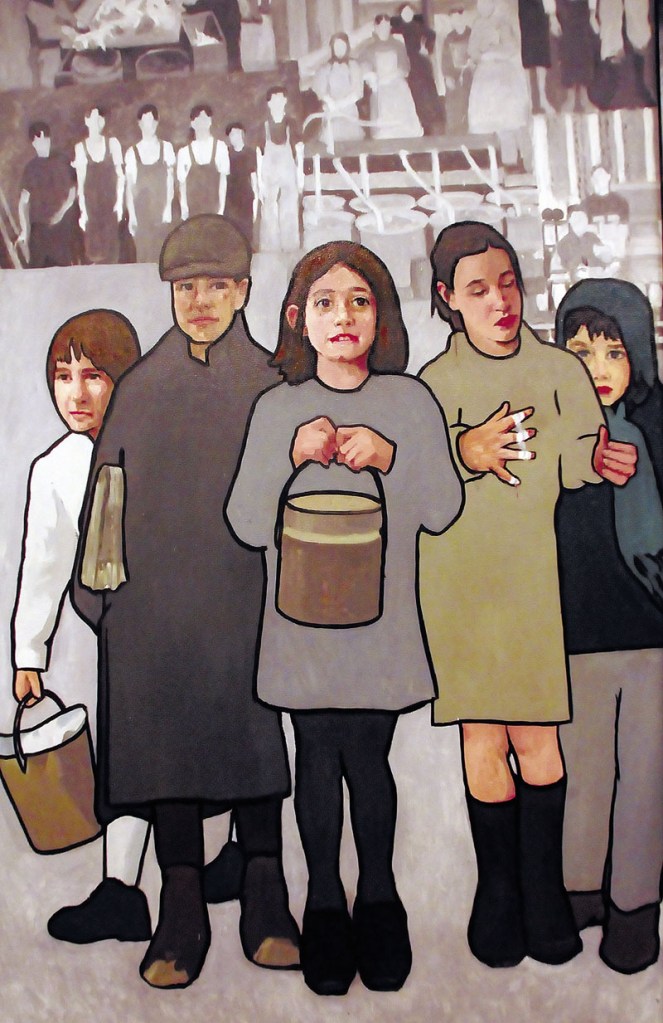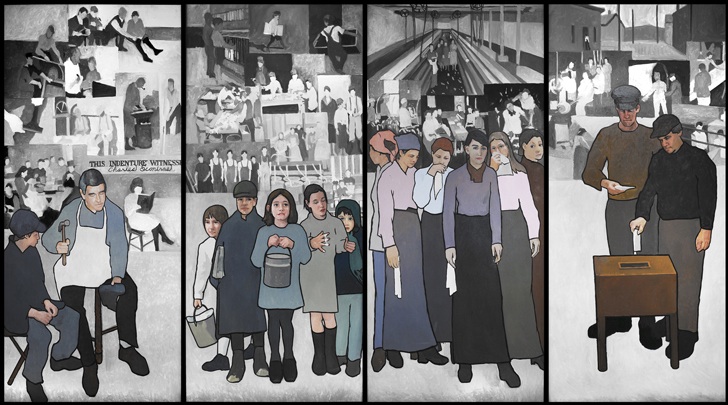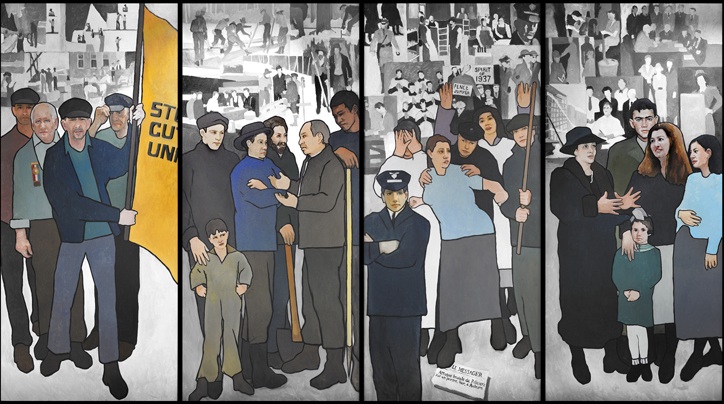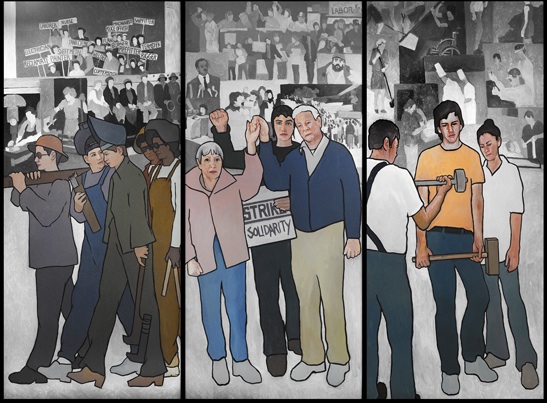AUGUSTA – Labor leaders and the state’s biggest Latino group expressed outrage Wednesday at Gov. Paul LePage’s decision to remove a mural depicting workers from the Department of Labor’s headquarters and rename conference rooms in the building.
Matt Schlobohm, executive director of the Maine AFL-CIO, called the decision “insulting to working people, petty and shortsighted.”
“It seems the governor is much more interested in picking fights with labor than creating jobs that people so desperately want,” he said. “We believe their story deserves to be told on the walls of the Department of Labor.”
The 36-foot-long, 11-panel mural depicts the state’s labor history, including a shoe worker strike in Lewiston, female shipbuilders and striking papermakers in Jay.
It also highlights dangerous working conditions, long work hours and child labor, according to a 2008 memo from the Department of Labor.
LePage explained his decision on the Boston-based Howie Carr radio show late in the day.
“I’m trying to send a message to everyone in the state that the state of Maine looks at employees and employers equally, neutrally and on balance,” he said. “The mural sends a message that we’re one-sided, and I don’t want to send that message.”
Ralph Carmona, spokesman for the League of United Latin American Citizens, said a directive to rename a conference room that’s now named for the late farm worker advocate Cesar Chavez is troubling.
“The really bad news is that his decision to remove a civil rights icon’s name from the Labor Department reflects an underlying pattern of actions and words that affect all Mainers,” he said.
That pattern includes LePage’s comment to the NAACP to “kiss my butt,” saying that women might grow “little beards” if they are exposed to the chemical Bisphenol-A, and a statement that he would go after union rights, Carmona said.
“What is next, the burning of books or the end of Labor Day as a holiday?” said Jose Lopez, director of the Latin American league. “When you add it all up, he is talking about business in a narrow sense that excludes Maine people and the public interest.”
LePage spokeswoman Adrienne Bennett said the governor’s office has received “several messages” from the public complaining about the mural. She also released an anonymous fax, dated Feb. 24, that apparently came from someone who recently visited the Labor Department’s lobby.
“In this mural I observed a figure which closely resembles the former commissioner of labor,” the person wrote. “In studying the mural I also observed that this mural is nothing but propaganda to further the agenda of the Union movement. I felt for a moment that I was in communist North Korea where they use these murals to brainwash the masses.”
The fax is signed “A Secret Admirer.”
Dana Connors, president of the Maine State Chamber of Commerce, said he has not received any complaints about the mural from businesses. But he said LePage is trying to follow through on his mission to make Maine more business-friendly by being sensitive to all interests.
He suggested a compromise to taking down all 11 panels of the mural.
“Instead of removing them all, maybe we could add a business element to it,” he said. “One that depicts the importance of employer and employee.”
David Clough, director of the Maine branch of the National Federation of Independent Businesses, said there is a need in Maine for better balance between small business and labor.
“Small-business owners would like to see a department that’s visually and substantively balanced between labor and the businesses that provide jobs for workers,” he said.
LePage spokeswoman Bennett also released a memo from acting Labor Commissioner Laura Boyett that asks staffers for suggestions about renaming the seven conference rooms, some of which are named after labor leaders.
Four rooms are named after women, including Marion Martin, the state labor commissioner from 1947 to 1972 who is credited with forming the National Federation of Republican Women; and Frances Perkins, secretary of labor under Franklin D. Roosevelt and the first woman to hold a U.S. Cabinet post.
Rooms also are named after Charles Scontras, a longtime University of Maine professor and a leading authority on Maine labor history, and William Looney, a Republican state legislator from Portland who helped pass child labor laws in the late 1800s.
In the memo, Boyett makes it clear to staffers that while they are awaiting a permanent labor commissioner, she wants the department to move ahead with changes.
“We have received feedback that the administration building is not perceived as equally receptive to both businesses and workers — primarily because of the nature of the mural in the lobby and the names of our conference rooms,” she wrote. “Whether or not the perception is valid is not really at issue and therefore, not open to debate.”
She asks workers to suggest names for the conference rooms by April 5 and indicates there will be “a small prize” for anyone who comes up with a new name. Boyett said that replacing the mural with a neutral paint and renaming the conference rooms after mountains in Maine would be appropriate.
The story generated heavy Web traffic Wednesday, including hundreds of comments on MaineToday Media’s websites.
“When will this governor, this state, this nation get it?” wrote SidneyBob. “Without labor there’d be no business. Without business there’d be no labor. They’re in this together. WE’RE in this together. Enough rancor, partisan politics, demonizing, taking sides … Divided we fall — and boy are we falling fast — as a state and as a nation.”
On the other side, someone named David supported LePage’s decision.
“Go Gov. Lepage!!! Finally someone who will take on the liberal/democrat/socialist/communityist Left that is taking over Maine!!!”
The mural was unveiled in August 2008, following the consolidation of five offices in the Augusta area and one in Lewiston to a central location on Commerce Drive in Augusta.
According to information released at the time, the state used $60,000 in federal funds to pay for the mural. LePage said officials are looking for museums in Maine that might be interested in displaying it.
Judy Taylor of Tremont, the artist who created and installed the work, was traveling Wednesday and could not be reached for comment. Her husband said they had been barraged by media calls, including one from The New York Times.
She told the Lewiston Sun Journal on Tuesday that she hadn’t heard any negative feedback about the mural from businesses.
“There was never any intention to be pro-labor or anti-labor,” she said. “It was a pure depiction of the facts.”
Scontras, the University of Maine professor, worked closely with Taylor to help create the mural. He said he finds it surprising that LePage, a Franco-American, would remove images that depict the workers who once were the “spine” of the state’s economy.
“He’s erasing a couple hundred years of history,” Scontras said. “I can’t imagine a governor who has the audacity to proceed this way when he can’t even win a runoff election.”
Scontras was referring to LePage’s victory in November with 38 percent of the vote.
In a statement released Wednesday, Maine AFL-CIO President Don Berry described the removal of the mural as “political payback, the opposite of putting people first.”
“It’s a spiteful, mean-spirited move by the governor that does nothing to create jobs or improve the Maine economy,” he said.
MaineToday Media State House Writer Susan Cover can be contacted at 620-7015 or at:
scover@mainetoday.com
Copy the Story Link
Send questions/comments to the editors.







Success. Please wait for the page to reload. If the page does not reload within 5 seconds, please refresh the page.
Enter your email and password to access comments.
Hi, to comment on stories you must . This profile is in addition to your subscription and website login.
Already have a commenting profile? .
Invalid username/password.
Please check your email to confirm and complete your registration.
Only subscribers are eligible to post comments. Please subscribe or login first for digital access. Here’s why.
Use the form below to reset your password. When you've submitted your account email, we will send an email with a reset code.